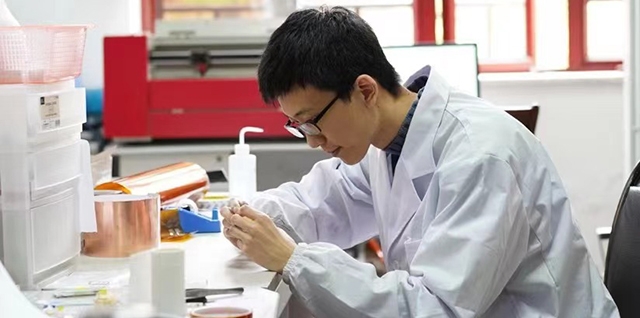Giving new voices
石墨烯:改變世界的神奇材料
How wonderful would it be if new technology could help the physically challenged?
如果新科技能幫助殘疾人士,那該有多好?
A smart wearable device that enables people with speaking disabilities to communicate normally is giving hope to those without a voice.
一種智能可穿戴的裝置可以幫助語言障礙人士正常交流,為其帶來希望。
Tao Luqi, a research fellow at Chongqing University,
據2017年發表在《自然通訊》上的一篇論文稱,
used a material called graphene to produce an artificial throat with a tiny sensor that allows people with speech impairments to speak normally,
重慶大學研究員陶璐琪使用石墨烯材料,制備出一種帶有小感應器的人工喉,
according to a paper published in Nature Communications in 2017.
可以幫助語言障礙人士正常“說話”。
Tao has continued his work on the device for the last four years.
在過去四年間,陶璐琪都在堅持研究這一裝置。
Although it’s a tiny mechanical sensor, it can work wonders.
雖然這是個微小的機械裝置,但它可以創造奇跡。

The device can detect weak vibrations and can produce sounds across a wide spectrum, from 100Hz to 40kHz, China Daily reported.
這個裝置可以檢測到微弱的振動,發出100Hz-40kHz的寬頻譜聲音,《中國日報》報道稱。
Humans can detect sounds in a frequency range from about 20Hz to 20kHz.
人耳可感知的聲音頻率在20Hz-20kHz之間。
“Although the speaking impaired people can’t speak, their throats can vibrate,” Tao told The Paper.
“聾啞人士雖然不能說話,但是喉嚨可以震動,”陶璐琪在接受澎湃新聞采訪時表示。
“If I put a device made of graphene into the throat of a person, it can detect the vibrations and make sounds using electrical signals.”
“如果我把一個石墨烯裝置放在人的喉嚨處,它就可以檢測喉嚨的震動,通過電信號發出聲音。”
Even whispers, screams and coughs at different frequencies can be recorded and encoded by the device, and it can arrange them into groups.
陶璐琪稱,甚至不同頻率的低語、尖叫、咳嗽都可以被這一裝置記錄下來、編碼、分類。
When the device detects the sounds in a particular group, it will reproduce the words, phrases or sentences, according to Tao.
當這一裝置檢測出特定組別里的聲音時,就會轉化出單字、短語或句子。
“But the speaking impaired people need to classify their own language sounds in groups and memorize them, just like typing keys on a keyboard,” Tao said.
“但聾啞人士需要將自己的聲音分類并記住,就像敲鍵盤上的字母鍵一樣,”陶璐琪稱。
Tao’s artificial throat has brought the possibilities of graphene to reality.
陶璐琪研制的人工喉使石墨烯的種種可能性變為現實。
It’s been 17 years since the discovery of graphene, and the world has been waiting for the “wonder material” to provide groundbreaking innovations.
人們發現石墨烯已有17年之久,世界都在等待這個“神奇材料”帶來突破性創新。
At only the width of an atom, graphene is the thinnest material known to humans – and also the strongest.
石墨烯只有一個原子那么寬,是人類已知的最薄、最堅硬的材料。
The material is also an efficient conductor of heat and electricity, and is ultra-lightweight, China Daily reported.
這種材料還具備很強的導電導熱性能,重量超輕,《中國日報》報道稱。
“Graphene really does have fantastic properties and its potential is huge,” said Khasha Ghaffarzadeh, a director at UK-based research consultancy IDTechEx.
“石墨烯確實具有優異的特性,它的潛力巨大,”總部位于英國的研究公司IDTechEx總監Khasha Ghaffarzadeh表示。
China has emerged as a key country for graphene production. Around 3,000 Chinese companies are exploring uses for graphene, according to government statistics in 2018,
中國已經成為石墨烯生產的主要國家。據《中國日報》稱,2018年相關部門統計數據顯示,
while half of the world’s graphene-related patents have been filed in China, according to China Daily.
約3000家中國企業正在探索石墨烯應用,全球一半的石墨烯專利來自中國。











